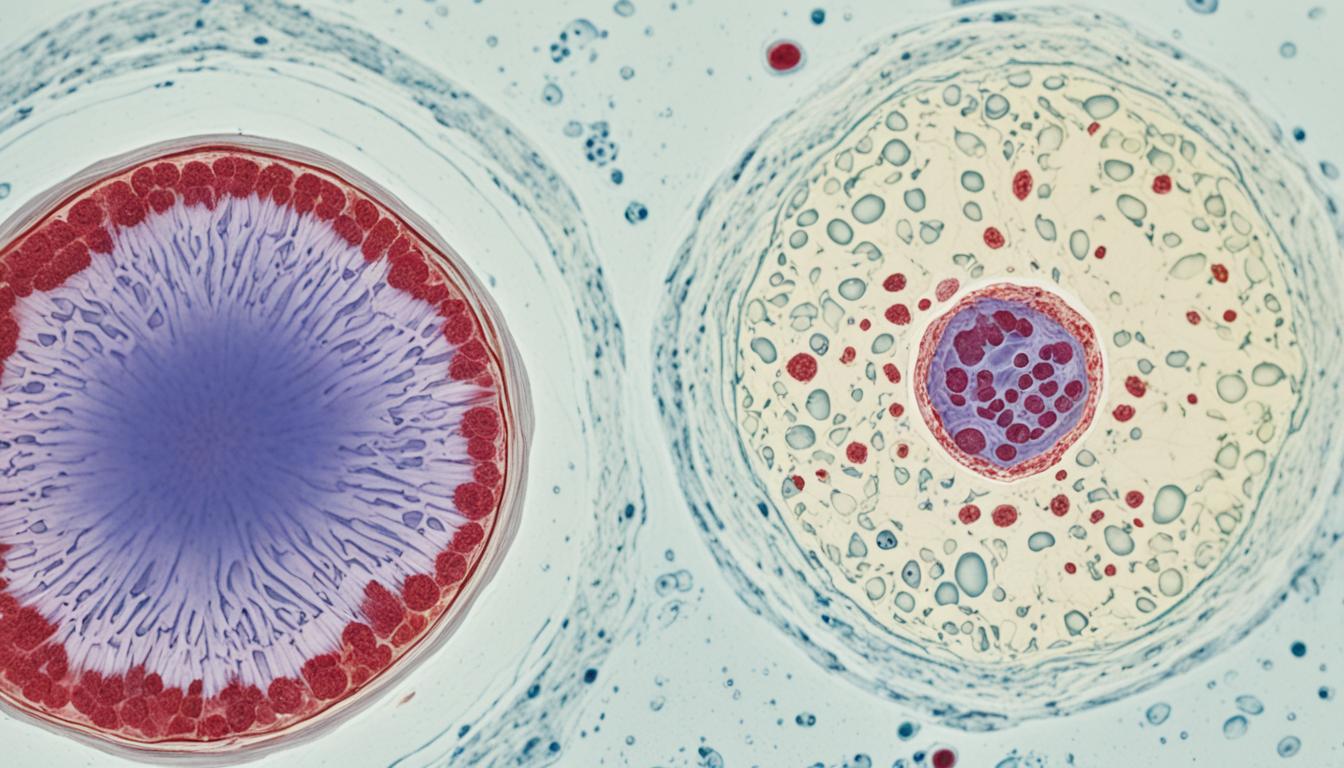Lactation mastitis is an inflammation of milk ducts in the breast. It usually happens within the first six weeks after giving birth. There are two types, non-infectious and infectious mastitis. The first is usually because the milk ducts get blocked. The second type is mainly due to a bacterial infection.
Mastitis shows as pain, swelling, redness, and possibly fever. It’s key to diagnose and treat it early. Treatment often includes antibiotics for the infection. Some doctors are also looking into using stem cell therapy.
Key Takeaways:
- Lactation mastitis is a common issue for women who are breastfeeding.
- Symptoms include pain, swelling, redness, and fever.
- Bacterial infection is a main cause of this condition.
- Getting the right treatment, like antibiotics and maybe stem cell therapy, can help a lot.
- Always see a doctor if you think you have mastitis.
Causes and Risk Factors of Mastitis
Mastitis, or lactation mastitis, can happen for many reasons. It’s important for new moms to know the causes and risks. This helps them avoid and deal with mastitis well.
Possible Causes of Mastitis
Mastitis often starts with nipple damage. This comes from breastfeeding incorrectly. It might be a bad latch or inverted nipples. Such issues can make the breast tissue sore and swollen. Infections are also a big cause. Bacteria can get in through cuts in the skin or nipple. To stay healthy, new moms need to keep their breasts clean and watch for any problems.
Another common cause is a blocked milk duct. If milk can’t get out, bacteria might grow and cause an infection. To stop this, new moms should breastfeed often. It’s also helpful to express milk by hand or with a pump.
Risk Factors for Mastitis
There are several things that can make mastitis more likely. One is if a mom has had it before. Tight bras that stop milk from flowing well are a risk, too. And using the same breastfeeding position all the time can cause the problem.
It’s really crucial for moms to look after their breasts. This means using the right breastfeeding methods and changing positions often. Getting help from a doctor as soon as mastitis symptoms show up is important. This can stop the problem from getting worse.
Knowing about mastitis helps moms handle it better. By understanding the causes and taking care of their breasts, women can have a better time breastfeeding. They can avoid problems and enjoy this special time with their baby.
Symptoms and Treatment of Mastitis
Mastitis is a common illness for nursing mothers. It can be painful and troubling. Recognizing the signs early and seeking help is very important. This helps to recover faster and avoid any problems.
Mastitis Symptoms
Here are some signs that you may have mastitis:
- Pain: Your breast might hurt, feel sore, or throb.
- Swelling and Redness: It might look bigger, get red, or have a lump.
- Heat: The area might feel warm when you touch it.
- Fever and Fatigue: You may feel like you have the flu, with a fever over 100.4°F (38°C), and very tired.
If you notice these symptoms, contact your doctor right away. They can help you figure out the best treatment.
Mastitis Treatment
There are several ways to treat mastitis, including:
- Antibiotics: If your mastitis is from bacteria, you’ll get antibiotics. Finish the whole dose to kill the infection.
- Pain Relief: Doctors might suggest medicines like paracetamol to help with pain, lower your fever, and make you more comfortable. Remember to talk to your doctor before taking any.
- Breast Emptying: Keep breastfeeding or pump often. This helps with symptoms and stops them from getting worse. If breastfeeding is hard, a lactation consultant can help make it easier.
- Surgical Drainage: In rare cases, you might need a small surgery to drain a breast abscess. Doctors do this in a sterile way to not cause more infections and help you heal.
Stick to your treatment plan and go to your check-ups. Your doctor will see how you’re doing and may suggest more steps if needed.
| Treatment Options | Advantages | Disadvantages |
|---|---|---|
| Antibiotics | – Effectively targets bacterial infection and promotes healing – Can alleviate symptoms and prevent complications |
– May cause side effects such as gastrointestinal upset – Potential development of antibiotic resistance |
| Pain Relief Medication | – Reduces pain, fever, and discomfort – Enhances overall well-being during recovery |
– May have contraindications or adverse effects for certain individuals – Long-term use may pose risks |
| Breast Emptying | – Removes infectious material and reduces swelling – Helps maintain milk production and prevent engorgement |
– May be challenging or painful for some individuals – Requires proper latch and breastfeeding techniques |
| Surgical Drainage | – Provides immediate relief by draining the abscess – Can prevent complications and promote faster healing |
– Requires a minor surgical procedure – May involve risks associated with anesthesia and surgery |
Conclusion
Lactation mastitis is tough for moms who breastfeed. But, it can be managed well with care. Using good breastfeeding techniques, changing positions often, and keeping your breasts clean can lower the risk. It’s also good to avoid tight bras to stop breast issues.
If you notice signs of mastitis, getting help quickly is vital. Doctors might give you antibiotics to fight the infection. They can also suggest pain medication to make you feel better. Sometimes, a small surgery is needed to drain an abscess. It’s crucial to keep breastfeeding or expressing milk to heal faster.
The future looks bright with stem cell therapy. It may lead to better ways to treat mastitis someday. As a breastfeeding mom, being proactive and sticking to prevention steps can help. This way, you can enjoy nursing while keeping mastitis risks low.

